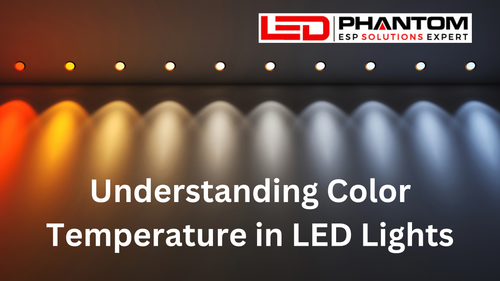Illuminate Your Way: Troubleshooting LED Issues & Understanding LED Phantom Glowing
Lighting technology has evolved rapidly, and LED systems now dominate both commercial and residential installations thanks to their energy efficiency, long life, and flexibility. However, even the best LED installations can run into issues that dim their performance if not managed properly. When your LED fixtures start flickering, dimming erratically, showing color shifts, or — particularly relevant here — led phantom glowing, those anomalies can lead to confusion and frustration. In this article, we will explore common LED lighting problems, dive deeply into what causes led phantom glowing, offer techniques to troubleshoot and prevent issues, and guide you to design, maintain, and optimize your “illuminate LED” systems for long-term reliability and performance.
The Promise & Challenges of LED Lighting
LED lighting offers many clear advantages: lower power consumption, long operational life, fast response times, and reduced maintenance. Because of these strengths, many businesses, municipalities, and homeowners have adopted LED systems for area lighting, indoor fixtures, retrofit upgrades, and smart lighting networks.
But to truly realize those benefits depends on getting the implementation right — from wiring and drivers to switches, controls, thermal management, and system compatibility. Even small mismatches or oversight in design can lead to recurring problems that erode performance and user confidence. Therefore, a proactive approach to diagnosis and troubleshooting is crucial.
When you aim to “illuminate LED” optimally — ensuring light is stable, uniform, responsive, and efficient — you must understand both typical failure modes and subtle issues like glowing, flicker, or color drift. That’s especially true in advanced setups such as those used in LED Phantom or other premium LED systems.
Common LED Lighting Problems & Their Causes
Here’s a breakdown of some of the most frequently encountered LED lighting issues — and what typically causes them. Knowing these helps you systematically track down and resolve performance anomalies.
1. Flickering Lights
Symptom: The LED fixture flickers or blinks intermittently (or continuously) rather than providing a steady glow.
Possible Causes:
-
Incompatible dimmer or switch (older dimmers often don’t fully regulate current for LED loads).
-
Poor or loose connections in wiring (voltage drops or intermittent contact).
-
Fluctuations or instability in power supply or driver.
-
Overloaded circuits or shared neutrals causing cross-interference.
Resolution Tips:
-
Use dimmers rated for LED loads (trailing-edge, PWM) rather than incandescent/analog types.
-
Tighten and inspect all wiring joints, connectors, and terminal connections.
-
Isolate circuits to avoid interference.
-
Upgrade to higher-grade LED drivers with better regulation.
2. Inconsistent Brightness / Dimming
Symptom: Some fixtures appear brighter or dimmer than others, or light levels change unintentionally.
Possible Causes:
-
Voltage drops over long runs or inadequate wire gauge.
-
Driver or module degradation (age, heat damage).
-
Mismatched LED modules or fixtures in the same circuit.
-
Over-temperature conditions causing automatic down-rating.
Resolution Tips:
-
Recalculate wiring runs and voltage drop; upgrade to appropriate gauge.
-
Replace or rebalance aging driver modules.
-
Use uniform fixture types or matched driver specs in the same zone.
-
Ensure proper heat dissipation and ventilation in fixture enclosures.
3. Color Inconsistency or Shifting
Symptom: LEDs in the same space show different color temperatures (CCT) or color drift over time.
Possible Causes:
-
Mixing different brands, batches, or CCT ratings in the same environment.
-
Driver instability affecting LED current.
-
Thermal stress causing changes in LED spectral output.
-
Aging or degradation of phosphor layers in some LEDs.
Resolution Tips:
-
Use the same product line, batch, or CCT value throughout.
-
Maintain balanced thermal management or heatsinking.
-
Monitor and replace aging fixtures before color shift becomes noticeable.
-
Choose drivers with stable current output under temperature swings.
4. Dead / Non-Working LED Modules
Symptom: One or more LED chips in a fixture fail or do not light at all.
Possible Causes:
-
Component failure (LED chip burnout).
-
Driver failure or short circuit.
-
Incorrect wiring polarity or connection.
-
Overcurrent or overheating stress.
Resolution Tips:
-
Test the driver and replace if faulty.
-
Replace only the affected module with module specifications matched exactly.
-
Verify wiring polarity and connections.
-
Investigate ambient conditions (e.g. heat, voltage surges) that might cause repeated failure.
5. Overheating & Thermal Stress
Symptom: Fixtures run hot, suffer reduced lifespan, or degrade brightness over time.
Possible Causes:
-
Poor heat sink design or inadequate thermal path.
-
Enclosed fixtures without adequate ventilation.
-
High ambient temperatures, inadequate airflow.
-
Overdriving LED modules (running beyond recommended power limits).
Resolution Tips:
-
Choose fixtures with built-in, effective heat dissipation (fins, aluminum housing).
-
Avoid placing fixtures in boxes or tight enclosures unless properly ventilated.
-
Ensure ambient environment is within rated temperature ranges.
-
Use drivers and modules that are not pushed near their maximum continuous output.
6. Delayed Response / Soft Turn-On
Symptom: Light takes time to energize (a sluggish ramp), or there is a delay in turning on/off.
Possible Causes:
-
Driver soft start or delay circuits.
-
Capacitive loading or residual circuits in dimmer/switch.
-
Interference or feedback in control wiring.
-
Weak supply or voltage stability issues.
Resolution Tips:
-
Use drivers with minimal delay or instant response specs.
-
Ensure control wiring is clean, separated, shielded if necessary.
-
Use direct switching for critical fixtures when delays are unacceptable.
-
Replace dimmers or switches that introduce lag or capacitive delay.
The Mystery of LED Phantom Glowing
One particular issue that’s often puzzling — and relevant to your keyword led phantom glowing — is when LED fixtures emit a faint glow (almost ghost-like) even when switched off. This is often called “phantom glow” or “residual glow.” It’s subtle, but in dark conditions or when fixtures are adjacent to live loads, it becomes visible and raises concern.
What Causes LED Phantom Glowing?
-
Residual / Leakage Current
Even with the switch off, minute current (leakage) may persist due to wiring capacitance, dimmer electronics, or parallel circuits. That small current can drive a few LED chips faintly. -
Incompatible Switches & Dimmers
Traditional dimmers do not fully cut off current; they may leak just enough power even in “off” state. With LED drivers being very efficient, that leakage is enough to produce a faint emission. -
Induced Voltage from Adjacent Wiring
When wires run parallel to live circuits, induction or capacitive coupling can inject a small voltage into the “off” line. The LED driver may interpret that as a weak power signal and allow a minor current to pass. -
Internal Driver/Circuit Standby Modes
Some advanced LED driver modules maintain micro-power circuits or standby electronics even when off. Poor isolation or leakage in those circuits may result in that glow.
Is LED Phantom Glowing a Safety Issue?
Generally, no. The current involved is very low and well within safety margins. However, it does indicate that your switch, wiring, or driver isolation may not be ideal. Addressing it improves system predictability, user comfort, and professionalism.
How to Prevent or Eliminate LED Phantom Glowing
-
Use LED-rated switches or trailing-edge dimmers that fully interrupt current rather than “bleeding” small current when off.
-
Add a bypass capacitor or snubber across the LED line or switch to shunt leakage current.
-
Reconfigure wiring to avoid coupling (run LED lines away from high-voltage lines).
-
Use higher quality, well-isolated drivers and units with better internal shielding.
-
Segment circuits so that non-LED loads do not leak current into LED lines.
When you plan and execute your lighting installation correctly, led phantom glowing becomes a rare, manageable quirk rather than an ongoing annoyance.
Best Practices to “Illuminate LED” Systems with Reliability & Quality
To make any LED lighting project — large or small — succeed, adopt these guiding principles:
1. Planning & Audit
Before deployment, audit existing wiring, switching systems, control infrastructure, and expected usage patterns. Model voltage drop, load distribution, and heat loads so your system can handle real-world demands.
2. Matching Components & Standards
Always match driver specs, wiring gauge, fixture types, and control modules. Don’t mix wildly different brands or quality levels in the same zone. Use industry standards for cable, grounding, and control interfaces.
3. Design for Thermal Stability
LED performance and lifetime depend heavily on thermal regulation. Provide adequate heatsinks, ventilation, ambient airflow, and avoid enclosing fixtures in heat-trapping boxes unless active cooling is provided.
4. Use Proper Dimmers, Switches & Controls
Select dimmers and switches specifically rated for LED loads. If using control networks or automation, ensure the control system supports stable PWM, low latency, and clean signal integrity.
5. Zone & Segment Your Circuits
Divide your lighting installation into logical zones (aisles, task areas, exteriors, showrooms). That allows you to isolate problems, reduce interference, and apply different control strategies per zone.
6. Calibration & Commissioning
After installation:
-
Test each fixture for flicker, color consistency, full brightness range, and responsiveness.
-
Use light meters to verify expected lux or lumen outputs.
-
Adjust or rebalance modules as needed so uniformity is preserved.
7. Maintenance & Lifecycle Management
-
Keep fixture hygiene: dust, debris, or surfaces reduce light output.
-
Monitor driver health, flicker, or dimming anomalies.
-
Log service events, environmental stresses, and replacements.
-
If modules degrade or shift in color, phase replacements in small batches to maintain consistency.
Advanced Considerations & Real-World Tips
-
In very large deployments, consider centralized monitoring / telemetry to flag anomalies (e.g. slight flicker, current drift) before users even notice.
-
For installations in high-temperature or industrial zones, overspec components to reduce stress margins.
-
Where possible, design for future upgrades (e.g. control systems, dimming additions) so you avoid rewiring or fixture replacement later.
-
Pay attention to supply chain: batch variations in LED modules or driver firmware can introduce subtle color shifts or behavior differences.
-
For aesthetic spaces, prioritize high CRI and stable color temperature over sheer lumen counts — users notice color rendering more than raw brightness.
Summing Up
When you adopt LED lighting, you likely expect consistent brightness, energy savings, long life, and reliability. But without thoughtful design, subtle problems can creep in — flicker, color drift, dimming inconsistencies, or even the mysterious led phantom glowing. By understanding what causes these issues, and applying rigorous planning, component selection, control strategy, and maintenance, you can ensure your lighting system performs as intended.
When your installations are clean, predictable, and responsive, you’ve truly mastered how to illuminate LED, not just in name but in effective, lasting quality. If you're using or considering LED Phantom solutions or any high-performance LED fixtures, this approach will help you avoid headaches and deliver on the promise of modern lighting.
Would you like me to refine this article for your target country (India, Europe, etc.), add section headings for easier reading, or generate optimized internal linking / content structure for your site?


